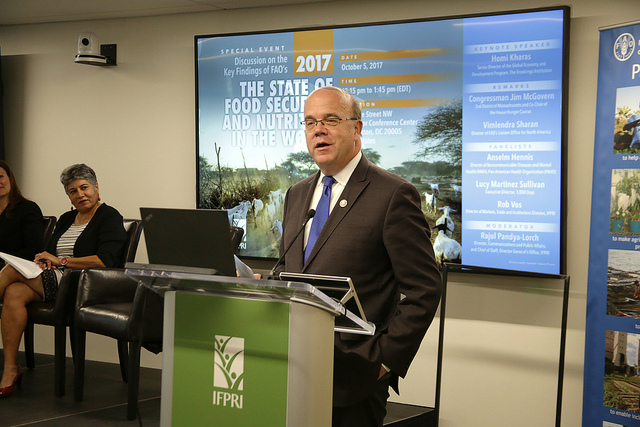For every 1,000 people around the world, around 108, many of them children, sleep on a near-empty stomach each night, according to the new UN Food and Agriculture Organization (FAO) report, The State of Food Security and Nutrition in the World 2017. Globally, the number of hungry rose substantially in 2016, from 777 million in 2015 to 815 million—the first increase since 2008. Coming on the back of a year of protracted violent conflicts in at least 13 countries and extreme weather in ten, the FAO findings are a wake-up call for the global community, participants at a recent IFPRI-hosted discussion of the report said.
“This [rise in number of hungry] is not news,” said Homi Kharas, senior director, global economy and development program, Brookings Institution. “The progress on hunger is not encouraging and we are off-track.” At current rates of progress, he noted, bringing stunting levels (low-height-for age among children under five) alone to zero would take another 40 years.
Violent conflict and extreme weather were major drivers of hunger in several parts of the world in 2016, said Kostas Stamoulis, FAO assistant director-general of economic and social development. Food security is closely linked to conflict: Nearly 80 percent of stunted children live in conflict countries. “Unless we change the way we work, combining humanitarian assistance with development, we will have a hard time in meeting the Sustainable Development Goal of ending hunger by 2030,” Stamoulis said. The frequency of the number of conflicts around the world has risen nearly 150 percent in the last 5 to 10 years, said Rob Vos, director of IFPRI’s Markets, Trade and Institutions Division—most occurring intra-state and in rural areas. Building resilience in countries facing conflict, Vos said, “is difficult as well as risky, but the fight against hunger will have to move hand in hand with fighting conflict.”
Earlier this year, famine was declared in parts of South Sudan, and warnings were issued for at least three other countries—Nigeria, Somalia and Yemen—putting a total of 20 million lives at the risk of starvation. “I hope bells are clanging in all capital cities across the world—including in Washington, D.C.,” said U.S. Rep. Jim McGovern (D-Mass.), co-chair of the House Hunger Caucus. McGovern said that U.S. global development aid as well as domestic food programs face likely budget cuts, and emphasized the need for advocacy groups to get their message out. “We have success stories. Let’s show a human face on those numbers and tell a story,” he said. “We can’t forget the people, especially since we are up against cynicism, and donor fatigue.”
Saving lives is important, but saving livelihoods to save those lives is important too, said FAO North America Liaison Director Vimlendra Sharan, adding the report’s findings are sobering and the international community needs to redouble its efforts. “We have a crisis right now,” said panelist Lucy Martinez Sullivan, executive director of 1,000 Days. Stunting and wasting are particularly devastating for Africa’s future, she said, and all these problems must be tackled holistically, including building a framework for action for leadership in the recipient countries and at the level of donors.
The report also focuses on the double burden of malnutrition: Hunger and undernutrition coupled with rising overnutrition and obesity. Many countries are experiencing simultaneously high rates of child undernutrition, anemia among women, and adult obesity. Meanwhile, childhood overweight and obesity are increasing in most regions, and in all regions for adults, mainly due to rapidly shifting dietary patterns, increasing globalization, urbanization and rising disposable incomes.
“For the first time in mankind’s history, our children will be sicker than we are, and have shorter lives than we do unless we put the regulatory frameworks in place to protect them,” said panelist Anselm Hennis, director for noncommunicable diseases and mental health (NMH) at the Pan-American Health Organization (PAHO). Countries must devise policy solutions to address the problem of overnutrition, he said.
Participants stressed the need to strike a balance between development and humanitarian assistance, while addressing problems at the institutional level of donors as well as recipient countries. They also emphasized on the need for disaggregated data, for telling stories of successful policies at a granular level—and the urgent need to “make noise” to draw global attention to rising hunger and malnutrition.
Smita Aggarwal is an IFPRI Communications Specialist.







